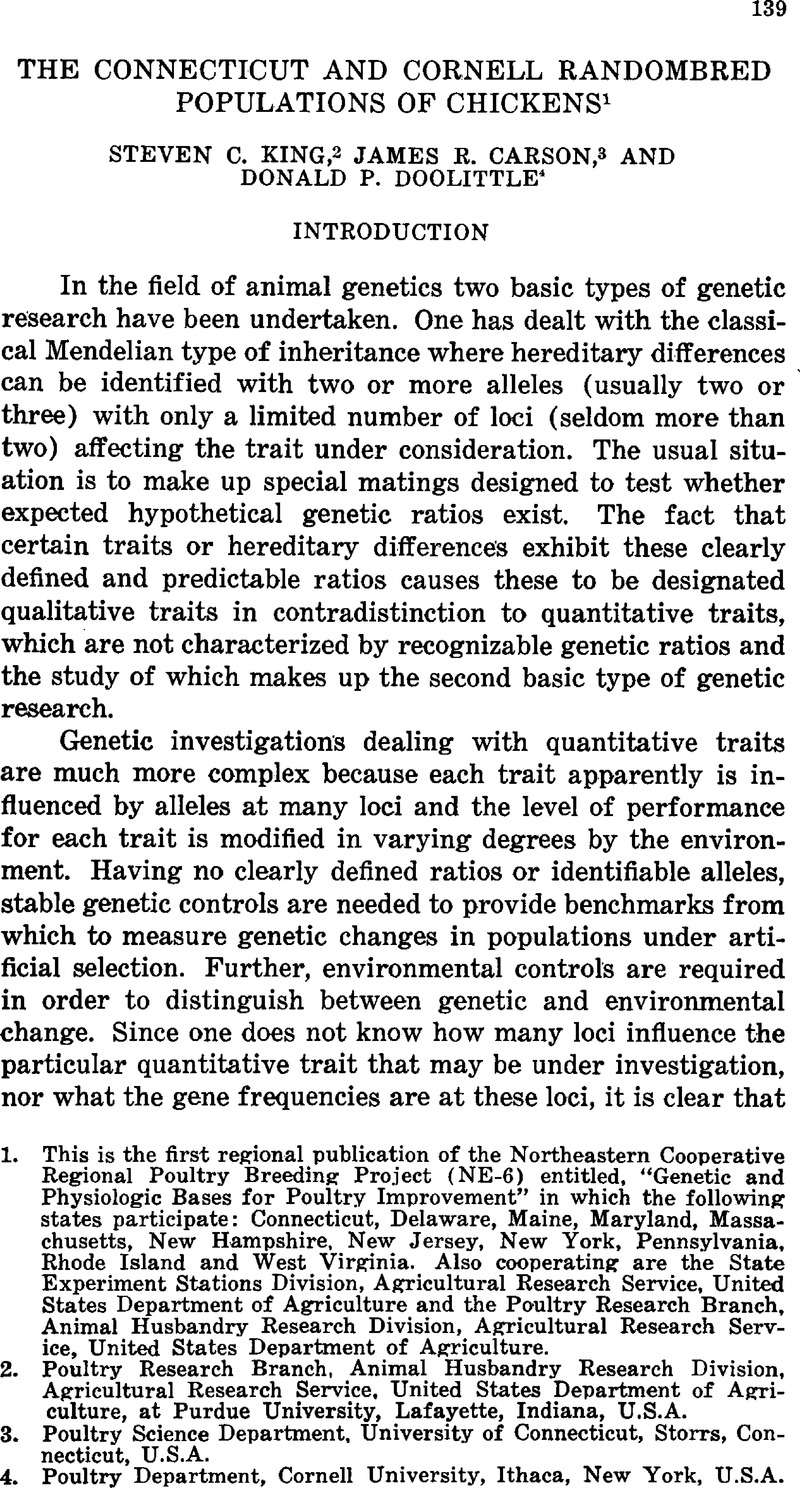Crossref Citations
This article has been cited by the following publications. This list is generated based on data provided by Crossref.
Cherms, Frank L.
Wilcox, F.H.
and
Shaffner, C.S.
1960.
Genetic Studies of Serum Cholesterol Level in the Chicken.
Poultry Science,
Vol. 39,
Issue. 4,
p.
889.
Craig, J.V.
Polley, C.R.
and
Wearden, S.
1960.
Estimation of Genetic Diversity by Skin-graft Reactions in Young Chicks ,.
Poultry Science,
Vol. 39,
Issue. 6,
p.
1533.
Tindell, Dale
and
Craig, J.V.
1960.
Genetic Variation in Social Aggressiveness and Competition Effects Between Sire Families in Small Flocks of Chickens , ,.
Poultry Science,
Vol. 39,
Issue. 6,
p.
1318.
King, Steven C.
Mitchell, J. David
Kyle, Wendell H.
and
Stadelman, W.J.
1961.
Egg Quality Genetic Variation and Covariation.
Poultry Science,
Vol. 40,
Issue. 4,
p.
965.
Bray, David F.
Bell, A. E.
and
King, S. C.
1962.
The importance of genotype by environment interaction with reference to control populations.
Genetical Research,
Vol. 3,
Issue. 2,
p.
282.
Wilcox, F.H.
and
Wilson, H.R.
1962.
Changes in Albumen Quality with Time.
Poultry Science,
Vol. 41,
Issue. 3,
p.
883.
Weiss, Harold S.
and
Textor, Kurt
1962.
Capacity of the Adult Chicken for Exercise on the Treadmill.
Poultry Science,
Vol. 41,
Issue. 3,
p.
760.
Hess, Carl W.
1962.
Randombred Populations of The Southern Regional Poultry Breeding Project.
World's Poultry Science Journal,
Vol. 18,
Issue. 2,
p.
147.
King, Steven C.
Van Vleck, L. Dale
and
Doolittle, Donald P.
1963.
Genetic stability of the Cornell randombred control population of White Leghorns.
Genetical Research,
Vol. 4,
Issue. 2,
p.
290.
Jaap, R. George
1963.
Selection for Rapid Growth Rate in Chickens.
Poultry Science,
Vol. 42,
Issue. 6,
p.
1393.
VanVleck, L. Dale
King, Steven C.
and
Doolittle, Donald P.
1963.
Sources of Variation in the Cornell Controls at Two Locations.
Poultry Science,
Vol. 42,
Issue. 5,
p.
1114.
Wilcox, F.H.
Cherms, F.L.
VanVleck, L.D.
Harvey, W.R.
and
Shaffner, C.S.
1963.
Estimates of Genetic Parameters of Serum Cholesterol Level.
Poultry Science,
Vol. 42,
Issue. 1,
p.
37.
Wilcox, F. H.
1963.
Genetic control of serum alkaline phosphatase in the chicken.
Journal of Experimental Zoology,
Vol. 152,
Issue. 2,
p.
195.
Smith, R.T.
and
Grover, Robert M.
1963.
Effect of Pre-Cooling Eggs and Cartons upon Quality after Storage.
Poultry Science,
Vol. 42,
Issue. 3,
p.
793.
Nestor, Karl E.
and
Jaap, R. George
1963.
Bi-Weekly Gland and Tissue Weights in Young North Central Regional Randombred Leghorn Chickens.
Poultry Science,
Vol. 42,
Issue. 4,
p.
989.
McCartney, M.G.
1964.
A Randombred Control Population of Turkeys.
Poultry Science,
Vol. 43,
Issue. 3,
p.
739.
Weinland, B.T.
Carson, J.R.
and
King, S.C.
1964.
Stability of Gene Frequencies in a Randombred Control Population of Chickens ,.
Poultry Science,
Vol. 43,
Issue. 4,
p.
985.
VanVleck, L.D.
and
Doolittle, D.P.
1964.
Genetic Parameters of Monthly Egg Production in the Cornell Controls.
Poultry Science,
Vol. 43,
Issue. 3,
p.
560.
Dickerson, Gordon E.
1965.
Random Sample Performance Testing of Poultry in the U.S.A..
World's Poultry Science Journal,
Vol. 21,
Issue. 4,
p.
345.
Lowe, P.C.
Wilson, S.P.
and
Harrington, R.B.
1965.
Association of Some Qualitative and Quantitative Traits in Chickens.
Poultry Science,
Vol. 44,
Issue. 1,
p.
106.



